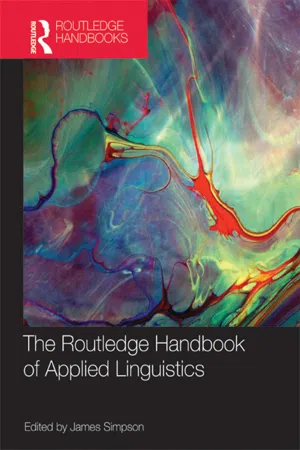
The Routledge Handbook of Applied Linguistics
James Simpson, James Simpson
- 732 pages
- English
- ePUB (mobile friendly)
- Available on iOS & Android
The Routledge Handbook of Applied Linguistics
James Simpson, James Simpson
About This Book
The Routledge Handbook of Applied Linguistics serves as an introduction and reference point to key areas in the field of applied linguistics.
The five sections of the volume encompass a wide range of topics from a variety of perspectives:
-
- applied linguistics in action
- language learning, language education
- language, culture and identity
- perspectives on language in use
- descriptions of language for applied linguistics.
The forty-seven chapters connect knowledge about language to decision-making in the real world. The volume as a whole highlights the role of applied linguistics, which is to make insights drawn from language study relevant to such decision-making.
The chapters are written by specialists from around the world. Each one provides an overview of the history of the topic, the main current issues and possible future trajectory. Where appropriate, authors discuss the impact and use of new technology in the area. Suggestions for further reading are provided with every chapter. The Routledge Handbook of Applied Linguistics is an essential purchase for postgraduate students of applied linguistics.
Editorial board: Ronald Carter, Guy Cook, Diane Larsen-Freeman and Amy Tsui.
Frequently asked questions
Information
Part IApplied linguistics in action
1 Language policy and planning
Introduction
LPP: a relatively brief history
Developing nation-states, developing LPP
those planned activities which attend to the valuation of language resources, the assignment of preferences to one or more languages and their functional ordering, and developing the language resources and their use in a manner consistent with the declared objectives identified as planned targets … successful language planning, or degrees of it, can be understood in terms of the efficacy of planned policy measures as well as the target populations’ propensity to comply with the public policies pertaining to language planning.
- The idea of a rational model (Jernudd 1973), where alternative ways of tackling a problem were carefully compared before settling on the optimal choice. This approach assumed that LPP issues could be approached in terms of a cost-benefit analysis.
- The distinction between status planning and corpus planning (Kloss 1969): the former was concerned with official decisions about the appropriate use of a language. The latter was concerned with developing the ‘nuts and bolts’ of language itself (its vocabulary, forms of pronunciation and syntax), so that a language could indeed serve its designated function.
- The distinction between processes of language selection, codification of the selected language as standard or correct, elaboration of the language form where necessary, and implementation to ensure that the standards were properly adopted (Haugen 1966). These processes were typically understood to apply sequentially, so that LPP would be pursued in a manner that was organized and systematic.
Looking within
The grand projects in third world nations more or less disappeared during the 1980s, either because of manifest failure, or because of a lack of interest, resources, or political importance. Language planning experts reoriented their work away from the creation of policies and plans towards the implementation of experimental and mostly small-scale (nongovernmental) projects, and towards assessments of past experiments and current situations. The enthusiasm for language planning as an academic subject faded in the wake of the collapse of state systems and economies in the third world.
- The unit of analysis employed: While the neoclassical approach focuses on individual choices, the historical-structural pays attention to relationships between groups.
- The role of the historical perspective: The neoclassical is more interested in the current language situation; the historical-structural, in contrast, emphasizes the role of socio-historical factors.
- Criteria for evaluating plans and policies: The neoclassical is primarily amoral in its outlook; policies are evaluated in terms of how efficiently they achieve their goals. The historical-structural is more sensitive to issue of domination, exploitation and oppression.
- The role of the social scientist: Consistent with its amoral out...
Table of contents
- Cover Page
- Half Title Page
- Title Page
- Copyright Page
- Table of Contents
- List of tables and figures
- List of contributors
- Acknowledgements
- Introduction: applied linguistics in the contemporary world
- Part I Applied linguistics in action
- Part II Language learning, language education
- Part III Language, culture and identity
- Part IV Perspectives on language in use
- Part V Descriptions of language for applied linguistics
- Index